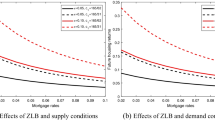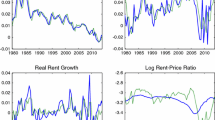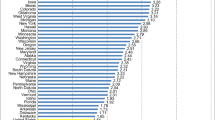Abstract
Crowding out arises in many economic contexts, from the macro concern that deficit spending might crowd out investment to the micro concern that increased employment of women might result in fewer jobs for men. Here I ask whether subsidized housing crowds out unsubsidized housing in the United States, applying the econometric tools of cointegration analysis. Such crowding out proves to require stringent restrictions on the coefficients of the cointegrating relationships that link housing stocks with one another and with other economic variables. These restrictions also apply to testing for other crowding out phenomena.
I find that public housing has steadily added to the total stock of housing since its inception in 1935. In contrast, I find that moderate-income, conventionally financed, subsidized housing, such as the Section 235 and 236 programs that accounted for more than 1.5 million new units between 1960 and 1987, most likely adds little or nothing to the total housing stock. These findings speak against recent proposals to provide subsidies to developers who build dwellings for moderate income Americans but offer qualified encouragement to those who advocate expansion of the conventional public housing program.
Similar content being viewed by others
References
Banerjee, A., et al. (1993). Cointegration, Error-Correction, and the Econometric Analysis of Non-stationary Data. Oxford: Oxford University Press.
Blackley, Dixie Marie. (1999). ``Housing Supply Models,'' Journal of Real Estate Finance and Economics18, 25–42.
Borsch-Supan, Axel, et al. (1992). ``Health, Children, and Elderly Living Arrangements.'' In David Wise, ed., Topics in the Economics of Aging (pp. 79–104). Chicago: University of Chicago Press.
Dickey, D., and W. Fuller (1979). ``Distribution of the Estimators for Autoregressive Time Series with a Unit Root,'' Journal of the American Statistical Association,74,427–431.
DiPasquale, Denise. (1999). ``Why Don't We Know More About Housing Supply?'' Journal of Real Estate Finance and Economics18,9–23.
Elwood, David, and Mary Jo Bane. (1984). ``The Impact of AFDC on Family Structure and Living Arrangements.'' In Research in Labor Economics. Greenwich, CT: JAI Press.
Engle, Robert F., and C.W. J. Granger. (1987). ``Cointegration and Error Correction: Representation, Estimation, and Testing,'' Econometrica 55(2) (March),251–276.
Engle, R. F., D. F. Hendry, and J. F. Richard. (1983). ``Exogeneity,'' Econometrica51,277–304.
Engle, Robert F., and B. Sam Yoo. (1991). ``Cointegrated Economic Time Series: An Overview with New Results.'' In R.F. Engle and C.W.J. Granger, eds., Long Run Economic Relationships (pp. 237–266). Oxford: Oxford University Press.
Follain, James R., Jr. (1979). ``The Price Elasticity of the Long-Run Supply of New Housing Construction,'' Land Economics55(May),190–199.
Granger, C. W. J. (1981). ``Some Properties of Time Series Data and Their Use in Econometric Model Speci®cation,'' Journal of Econometrics16,121–130.
Granger, C.W. J., and Paul Newbold. (1974). ``Spurious Regressions in Econometrics,'' Journal of Econometrics 2,111–120.
Hakkio, Craig S., and Mark Rush. (1991). ``How Short Is the Long Run?,'' Journal of International Money and Finance 10(4) (December),571–581.
Hylleberg, S., R. F. Engle, C. W. J. Granger, and B. S. Yoo. (1987). ``Seasonal Integration and Cointegration.'' UCSD Discussion Paper, La Jolla, CA, July.
Jargue, C., and A. Bera (1980). ``Efficient Tests for Normality, Homoskedasticity, and Serial Independence of Regression Residuals,'' Economics Letters,6,255–257.
Johansen, Soren (1988). ``Statistical Analysis of Cointegration Vectors,'' Journal of Economic Dynamics and Control,12(June/September),231–254.
Johansen, Soren, and K. Juselius. (1990). ``Maximum Likelihood Estimation and Inference on CointegrationÐ With Applications to the Demand for Money,'' Oxford Bulletin of Economics and Statistics (May),169–210.
Lee, Tae-Hwy. (1992). ``Stock-Flow Relationships in U.S. Housing Construction,'' Oxford Bulletin of Economics and Statistics54,419–443.
Mayo, Stephen. (1981). ``Theory and Estimation in the Economics of Housing Demand,'' Journal of Urban Economics11,95–116.
Mayo, Stephen. (1988). ``Sources and Inef®ciency in Subsidized Housing Programs: AComparison of U.S. and German Experience,'' Journal of Urban Economics 20(2),229–249.
Murray, Michael P. (1983). ``Subsidized and Unsubsidized Housing Starts, 1961–1977,'' Review of Economics and Statistics 65(4) (November),590–597.
Murray, Michael P. (1994). ``A Drunk and Her Dog: An Illustration of Cointegration and Error Correction,'' The American Statistician48(February),37–39.
Orr, Larry. (1976). ``Income Transfers as a Public Good: An Application to AFDC,'' American Economic Review 66,359–371.
Peterson, George. (1979). ``Federal Tax Policy and the Shaping of Urban Development.'' In Arthun Solomon ed., The Prospective City (pp.399–425). Cambridge, MA: MIT Press.
Rydell, Peter C. (1979). ``Short-Run Response of Housing Markets to Demand Shifts.'' RAND Report, R-2453-HUD, Santa Monica, CA, September.
Sims, Christopher. (1980). ``Macroeconomics and Reality,'' Econometrica 48(1) (January),1–47.
Stock, James H., and Mark W. Watson. (1988). ``Variable Trends in Economic Time Series,'' Journal of Economic Perspectives (Summer),147–174.
Swan, Craig. (1973). ``Subsidized and Unsubsidized Housing Starts,'' American Real Estate and Urban Economics Association Journal1(Fall),119–140.
U.S. Department of Housing and Urban Development. (1973). Housing in the Seventies. Washington, DC: U.S. Government Printing Office.
Author information
Authors and Affiliations
Rights and permissions
About this article
Cite this article
Murray, M.P. Subsidized and Unsubsidized Housing Stocks 1935 to 1987: Crowding out and Cointegration. The Journal of Real Estate Finance and Economics 18, 107–124 (1999). https://doi.org/10.1023/A:1007741630145
Issue Date:
DOI: https://doi.org/10.1023/A:1007741630145




